What made the story, and the outrage, so huge? Half of it is due to Cecil the Lion himself. Of that, part is simply that he was a lion. People are uniquely drawn to cats of all kinds, in good and bad ways, in part because, like us, they are intelligent, have forward-facing eyes, are devoted to their families, and have a well-ordered social structure. Cats appeal to our human need to nurture, our powerful sense of touch mingled with our capacity for imagination—even the biggest lion looks cuddly—and to our respect for self-sufficiency and independence.
African lions are especially charismatic. Of the tens of thousands of species of warm-blooded animals on the planet, this is one of the most recognizable, for children as well as adults, in most cultures. The “king of the jungle” figures in Aesop’s fables, the biblical tale of Daniel in the lion’s den, and astrology’s Leo. Richard the Lionheart was given his nickname for his courage—a characteristic we attribute, fairly or unfairly, to lions. The flag of Sri Lanka depicts a sword-wielding lion. Singapore’s very name is derived from the Malay words singa for lion, and pora for fortress. The mythical Sphinx has the mane and body of a lion.
Lions also figure in some of the most beloved children’s stories and movies of our time: The Wizard of Oz, The Lion, the Witch, and the Wardrobe, and The Lion King. The popular song “The Lion Sleeps Tonight,” written and originally recorded in Zulu in 1939 by South Africa’s Solomon Linda with the Evening Birds, has been covered by a great many pop and folk musicians. The most well known English version, by the Tokens, became a number one hit in the US over a half a century ago, in 1961. During his lifetime, Linda was never fairly compensated for writing the original song, but Rolling Stone did a story about it after the song had earned $15 million for its use in the movie The Lion King, leading to a belated settlement for Linda’s estate—just one of myriad examples of how, as with trophy hunting itself, wealthy and powerful non-Africans exploit the natural and cultural treasures of Africa.
Cecil's being a lion made the situation even more fraught for the obvious reason that lions are endangered. In 2012, there were an estimated 32,000 remaining in the wild in all of Africa, restricted to an area less than 20 percent of their historical range. Unfortunately, their increasing rarity has made them more valuable for trophy hunters, and sure enough, trophy hunting for lions has increased in recent decades.
The fact that Cecil was a well-known individual lion made the situation even more emotionally fraught. His unique black mane made him exceptionally photogenic and recognizable, and his relatively calm acceptance of people made him one of the most easily photographed of Hwange’s lions. That relative tameness also made him an unfairly easy target compared to other lions.
The fact that Cecil was a valuable part of an Oxford University research project, wearing a GPS collar, made his loss even more egregious.
It is human nature to feel more intense outrage at the loss of a single individual than a whole population—to get more up in arms about shooting one lion than about all the declining species being gunned down worldwide, every day, by hunters, much less about all the critical habitat being destroyed worldwide, every day. Admittedly, some of the people angriest about Cecil are abysmally ignorant about nature. I’ve seen at least one photo of him when he was alive and well, with bloodied mouth and mane, being sent around social media as an image of the poor lion’s suffering. That was obviously posted by someone who imagines the African savanna as a “peaceable kingdom”—someone who certainly was never aware of, much less actually wept for, the zebras and wildebeests Cecil and his mates fed on, animals still kicking as the lions started devouring them.
The mirror image of naive ignorance about nature is the glamorizing of predation—romanticizing that notion of “nature red in tooth and claw.” The very idea of lions being "brave" for overcoming their herbivorous prey with huge, muscular bodies, powerful claws, and enormous teeth and jaws is as silly as saying that someone operating a slaughterhouse is brave for bringing down chickens, pigs, or cows, or that a goldfinch is brave for ripping seeds from a flower. Animals gather their food, whether plant or animal, with tools evolved specifically for getting that food. It has to do with the fundamental necessity of hunger, not bravery.
Whether people glamorize predation, close their eyes to it, or do their best to understand nature in all its complexities, much of the universal outrage about Cecil the lion is due to his being one particular animal with a name. And this is why some people who try hard to be objective and understand all the complexities of the natural world get outraged themselves, frustrated that the plights of whole populations, whole species, and critical habitats don’t muster even a fraction of the outrage that the killing of one individual lion has.
This focus on the individual is not a bad thing—it’s simply human. As a normally monogamous species that doesn’t bear young in large litters but individually, our human capacity for intense caring and nurturing is enlarged one by one, not on a population scale.
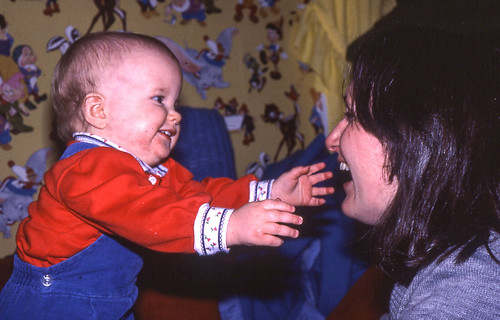 |
| We humans naturally tend to bond to little creatures one at a time. |
It takes maturity and an ability to visualize life outside our personal experience to start caring for individuals, much less whole groups or populations of humans or animals, that we haven’t spent time with personally. As we grow in experience, knowledge, and imagination, the circle of those we care about usually enlarges, first including our immediate family, then extended family and friends, then our neighborhood, and our city, and our state, and our country, and our world. Caring about natural habitats and populations begins as an intellectual concern, but doesn’t usually become soul-deep or at least deep in our guts until we’ve spent time deep within those habitats, drinking in the sights and sounds and smells, and exploring the plants and animals within them.
Reading about animals and habitats, or watching nature programming, can help a person develop an interest that eventually evolves into genuine and informed caring. Having a stuffed Lion King doll or a plush Hubert the Harris Lion (once the mascot of the Harris Bank), or a Braveheart the Care Bear lion hardly makes one understand real lions—pretending any predator is cuddly is ridiculous—but toy lions may give people a predisposition to care about real lions, at least in the abstract.
National conservation organizations capitalize on that. Both the National and International Wildlife Federations provide plush figures of endangered species as premiums in exchange for contributions.
After my close encounter with a mountain lion in Big Bend National Park in 2013, I bought a little plush mountain lion in the gift shop as a souvenir—most of the people who buy them aren’t lucky enough to have seen a real one, but somehow there’s magic in knowing you’re in a place where iconic creatures live even when you don’t get to experience them first hand. My fuzzy little stuffed animal is a pitiful representation of the magnificent cougar I came upon, but since I didn't get a photo, it's all I have.
 |
| My trophy mountain lion |
Zoos used to be the place where most people experienced, up close and personal, a variety of exotic, undomesticated animals. The zoos of my childhood didn’t have much by way of natural settings for the animals—some were put in extremely small cages relative to the animals’ sizes and activity levels. Lions were caged alone and spent their waking hours pacing back and forth restlessly—even as a small child I could tell they were unhappy, though as a small child I had no clue that lions lived anywhere outside of zoos. People with subscriptions to National Geographic or a membership in the International Wildlife Federation could learn about them in the wild, and they were often featured on TV, though the camera work and editing often involved ethical lapses that could be harmful to animals and misleading to viewers.
When I became a birder and started watching animals in the wild, it struck me that most nature programming focuses almost entirely on sex and bringing down prey—exciting and important elements of their lives, to be sure, but things that even Peregrine Falcons and lions spend only a tiny portion of their lives doing. In the past few years, thanks to streaming video technology, millions of people have been getting extremely intimate views of a great many species, from hummingbirds and puffins to hibernating bears and migrating Whooping Cranes, in real time, unedited, showing the animals in their day-to-day lives punctuated only rarely by the kinds of dramatic scenes emphasized in nature movies.
Wildlife cams bring people deep into the lives of animals. I helped monitor a chat room the first year that the Cornell Lab of Ornithology had a streaming nest cam on a Great Blue Heron nest. The birds were thrilling to watch, and I learned a tremendous amount about heron courtship, mating, nesting, and nurturing behaviors, and how baby herons grow, adapt to one another, and learn about the world around them. I also learned a lot about human nature.
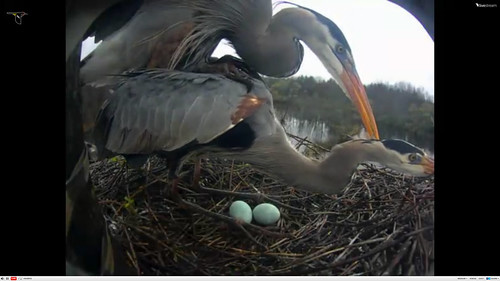 |
| Great Blue Herons mating right after the female laid her second egg. |
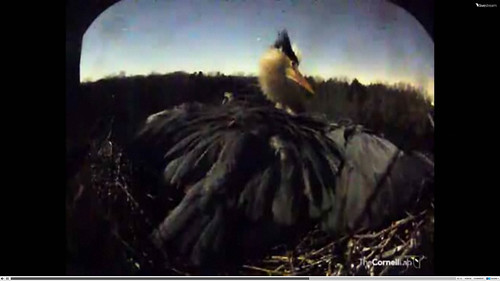 |
| Female Great Blue Heron after the owl attack. |
One egg did get dented—we presumed that in the first attack, when the mother heron hunkered down fast, she pressed too hard too suddenly on the egg. We couldn’t help but be concerned. Some monitors prepared viewers for disappointment, saying that egg was not likely to hatch. The cracks could make the egg dry out, making it more likely to break open prematurely or causing a deformity in the chick, but I didn't know enough about how often heron eggs crack and what percentage of them end up hatching to make a scientific prediction at all. That egg ended up being second to hatch, and produced a perfectly healthy chick.
 |
| The pipped egg on the right is the one with the dent, which is visible on the bottom. |
The first three chicks to hatch had a big head start over the last two, and the last one to hatch was at a significant disadvantage at feeding time. One natural human response when seeing an individual, recognizeable tiny, vulnerable creature is to name it, and people started calling the little guy “Fiver.” As the eggs had hatched, people had come up with various names for the others, but it quickly became impossible to tell them apart, so Fiver ended up the only one with a name that stuck. Some people who were aware that siblicide is a fairly common occurrence in herons and egrets started discussing worst-case scenarios, or begging the Lab to go “rescue” Fiver. I read every scientific paper I could lay my hands on about siblicide in herons, and discovered that while it’s very common in Great Egrets, it’s extremely rare in Great Blue Herons. Even if its siblings didn’t kill Fiver, it was possible that it would starve because the older, bigger babies were getting the lion’s share at feeding times, but I’d noticed that whenever one of the parents arrived to feed the young, it waited until all five were paying attention, and every single time I observed it, the parent regurgitated the pile of food closest to the two tiniest herons. Every time.
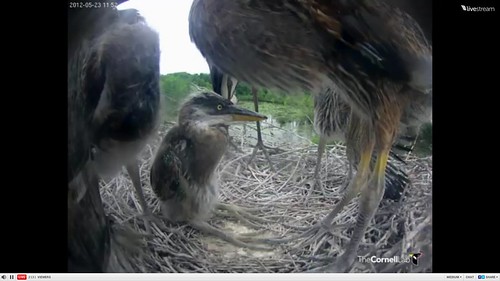 |
| "Fiver" |
Fiver became extremely quick at grabbing morsels and retreating. Would it survive? I had no clue, but figured we didn’t have nearly enough data about other heron nests to make a statistical prediction either way. It was as unscientific to assert that Fiver would die as that it would make it. Some people couldn’t deal with the uncertainty and the intense feelings the tiny chick’s vulnerability aroused; they stopped viewing. In the end, Fiver was the last to fledge, but that was just fine.
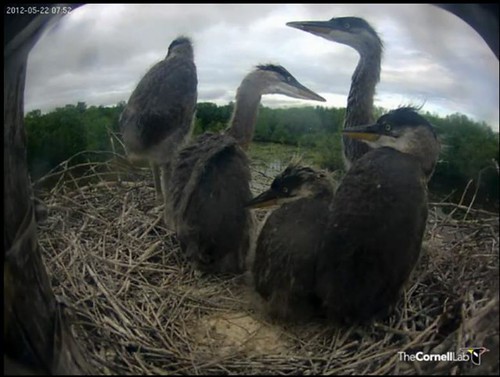 |
| Fiver, the littlest of all. |
None of the baby herons have been banded, so out of the nest, were no longer easy to identify. The adult male who helped build the nest in 2009, and nested successfully in the tree with the cam each spring until the nest fell out of the tree in 2014, was easy to keep track of because he was missing his hind toe on one foot and a front claw on the other. Each spring when "Dad" returns, thousands of people rejoice. In 2015, he injured one of his toes, probably in a fight with another heron. Viewers have been keeping special track of him, and so far he seems to be healing well.
When people develop an intense attachment to an individual, the distress when something bad happens is intense. But the joy when an egg hatches, when a chick defeats the odds and fledges, when a bird we were attached to last year returns in the spring—those joys are also intense.
Joyful happenings in nature happen constantly, but tragedies get more attention. Tens of thousands of people were devastated in 2012 when Petey the Atlantic Puffin, on Seal Island in Maine, struggled to eat the fish his parents were bringing him, butterfish—a species that puffins usually never bring their chicks because butterfish are too wide-bodied for the chicks to swallow. Day after day, Petey grew increasingly weak and finally starved to death on camera—the only chick in the only puffin nest with a live-streamed cam. The fishing that year was awful—high water temperatures brought in a different composition of fish, and puffin parents throughout the area were bringing in butterfish instead of the normal herring, white hake, and other narrow-bodied fish. Only 31 percent of puffin chicks survived.
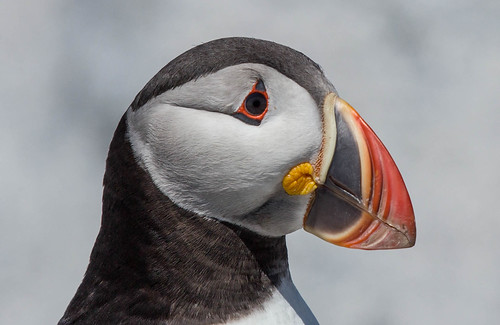 |
| How can anyone not care about these charismatic birds when they watch them closely? |
Reactions to the puffling's death were instructive. Some people denounced all wildlife cams because this one showed the poor puffin chick’s death so graphically when there was nothing people could do to save it. A few people went on in an almost salacious way about “nature red in tooth and claw,” as they so often do when raptor chicks kill a sibling, romanticizing and even glamorizing the harsh realities of life. Others became more impassioned advocates regarding issues surrounding climate change, seeing a larger picture.
As a species, human beings have a perhaps unique capacity to engage both heart and intellect simultaneously, but a fraction of us may be either genuinely unfeeling with no ability to empathize or suffer such unbearable discomfort in sad situations that they can only ameliorate it by acting as if the situation is fun and exciting to watch. I saw that first hand in college, when researchers in my department were studying PCBs and wildlife. In one study, they were exposing adult female ducks to varying levels of PCBs, and then finding out what the levels were in eggs, newly hatched ducklings, and several-day-old ducklings. This was in the early 70s, and the method used for analyzing levels in duckling tissue involved grinding up their entire bodies in a blender. The professors naturally assigned grad students to do their dirty work. Some students broke the necks of the ducklings first; others, too squeamish or cruel, dropped them, still alive, into the blender. In the day or two before and after a batch of ducklings was “processed,” some of the students looked traumatized, while others made over-the-top jokes about “grinding up baby ducks,” clearly aiming to distress their listeners. Was arousing discomfort in others their coping strategy, or were they simply lacking the human quality of compassion?
In watching natural events unfold, one doesn’t need to romanticize or thrill at the concept of survival of the fittest to accept that statistically it really is the rule. And one needn’t be emotionally invested or romanticize plucky little survivors to accept that in nature, sometimes vulnerable and even weak individuals do in fact survive.
The best thing about wildlife cams is that as people become invested in individual animals, they start feeling empathy for them, which for many is a necessary first step in caring about that species. The worst thing about cams is that because we watch them as we do movies and you-tube videos, on TV or our computers, we can’t help but think of them as entertainment. Unlike what we call “reality TV,” nest cams show real reality, graphically, as it unfolds minute by minute, unedited, without parental warnings or a 10-second delay when intense, tragic scenes are about to unfold.
Through cams, we get to see wildlife completely unaware of being observed, something that scientists, birders, and people who go on wildlife safaris for photography or hunting can never be sure we're seeing. Deer hunters often tell me about the chickadees that visit them in their deer stands. Chickadees are, of course, extremely inquisitive and observant, but deer, whose very lives are at stake and have a keen sense of smell, probably notice and successfully elude hunters, at least up until the one time they don't. Some of my hunting friends complain about how few deer there are nowadays compared to when they were young, even in areas where huge numbers of deer are damaging habitat. I suspect that more and more deer have simply learned to avoid areas with deer stands during hunting season.
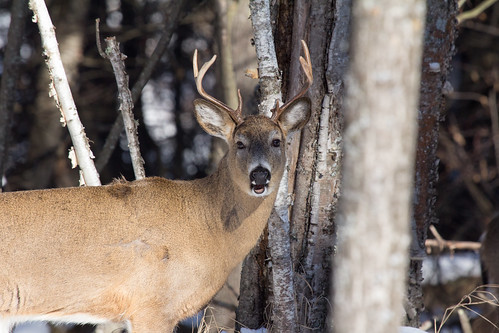 |
| This handsome buck was photographed in town in Two Harbors, MN, an excellent place for an intelligent game animal to hide out from hunters. |
No matter how good cams are, they don't immersed us in the habitat. We don’t see the animals away from the cam, and don’t always understand the bigger picture. In the case of Petey the baby puffin, ornithologist Stephen Kress had to look in other puffin nests to piece together the fact that every puffin was having trouble finding the right-sized fish that year. Then he looked into ocean currents and temperatures to work out the reason for it. Had Petey been one of the lucky 31 percent, it’s possible that no one would have paid attention to what was happening to the other baby puffins—at least not in a way that engaged and informed tens of thousands of people about one tragic problem associated with climate change.
Research helps us see the big picture about populations, but each population is made up of individuals who vary far more widely in intelligence, keenness of senses, behavior, and even “personality,” than most scientists and other people appreciate. These differences become apparent for those who watch cams. Intriguingly, the two hunters I’ve known who found themselves rescuing an orphaned fawn wanted their "babies" eventually released in a refuge where they would never be hunted. It is human nature to nurture helpless creatures, and human nature to want to ensure their future safety even when they no longer need our protection.
That impulse to nurture young as we help them reach independence, and to maintain our bond and the urge to help even as they no longer need parental care, is how we survive as a species. Some scientists are starting to appreciate that empathy is as natural an impulse as aggression is in many individuals of many social species. It may have been one element in the case of an Eastern Screech-Owl that repeatedly incubated the eggs of Northern Flickers nesting in its roost tree. When the young flickers hatched, the owl even tried to feed them bits of a bird it had killed. In the same way that the owl continued being a predator, it’s not surprising that sports hunters who form a bond with an individual game animal don’t necessarily stop hunting other animals of the same species because of the experience.
When word first got out about Cecil the lion being killed, a great many hunters were among the people denouncing his loss, in part because of his being named and collared. Although the collar did exacerbate the tragedy, I don’t see how that in particular made his shooting a worse crime. Even a large GPS collar on an animal with a healthy mane is not easy to spot. Of all the photos I’ve seen of Cecil, I’ve not been able to spot his collar in any, so wouldn't expect someone shooting him to notice it either.
If Cecil’s loss is so deeply felt because of his being one particular individual lion, he’s now ironically become a tragic statistic: the 24th of 62 collared lions in Oxford's project that have been shot by hunters. Only 10 others have died during the study from all other causes, establishing that hunting represents the primary cause of mortality for the lions living within a protected national park. This is horrifyingly unsustainable, but somehow the previous 23 lions’ deaths had gone unnoticed by most people. The death of one particular handsome, black-maned lion, an individual named Cecil, brought into sharp relief the much bigger problem.
A lot of conservationists and environmentalists hate how passionate people get about individuals instead of whole populations. But if the goal is to protect a variety of threatened and endangered species, instead of whining about a powerful element of human nature that we can’t do anything about, we should be working with that element of human nature. If we focused wildlife cams on individual sage grouse and prairie chickens and gave them names, people would learn up close and personal about these splendid birds, and also learn to care about them as they cared about about Cecil the Lion.
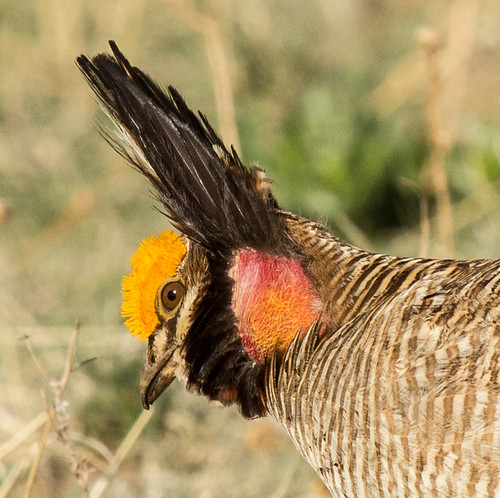 |
| If people could watch individual Lesser Prairie-Chickens up close and personal, maybe they'd learn to care about them. |
Cecil’s death was a horrible thing. But if it sparks a more careful analysis of trophy hunting, at least something good would come of it. And if people can learn to be as passionately outraged by the plight of other less well known endangered animals as they have been about Cecil, that would be a very good thing indeed.
